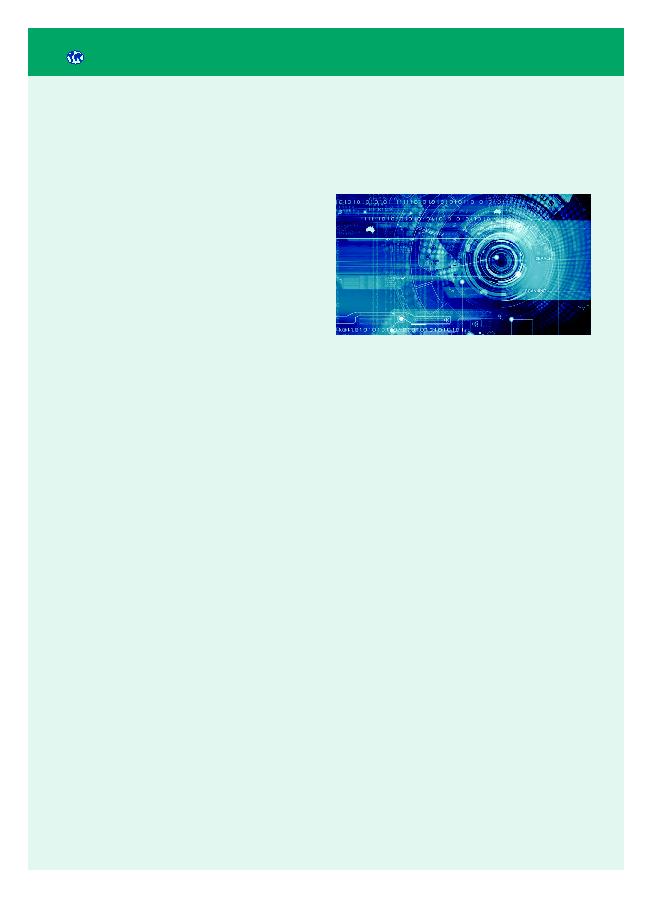
Cyber security a growth factor
for the access control market
The global market for access control in 2021 had
sales of about $8.5 billion and is expected to grow
by about 8 percent annually until 2027, according to
a report by market research firm Imarc Group. A sig-
nificant growth factor is the demands for increased
security in general and cyber security in particular.
Imarc Group emphasises that
more and more people are work-
ing remotely since Covid hit the
world and that this has presented
companies with new challenges
at a time when cyber attacks are
increasing sharply. Preventing data
breaches and ensuring business
continuity has become an increas-
ingly high priority in organisa-
tions worldwide.
Video surveillance
manufacturers were first
Of the electronic physical security
sectors, video surveillance manu-
facturers were the first to push
for increased cyber security. This
after some large high-profile cyber
attacks occurred in the 2010s,
where the network intrusion be-
gan with the hacking of connected
video surveillance equipment and
came to cause serious damage. At-
tention to cyber attacks intensified
when the US government, citing
national security, banned a num-
ber of Chinese companies from
government and infrastructure-
sensitive installations, including
well-known video surveillance
equipment manufacturers Hikvi-
sion and Dahua, but also Huawei.
Focus on cyber threats
after excommunication
The ban is filed under the John
McCain National Defense
Authorization Act (NDAA) and
restricts the use, procurement or
sale of certain brands of surveil-
lance equipment to or for federal
agencies. Government agencies
are not only prohibited from
purchasing equipment from these
manufacturers, but also from
doing business with contractors
who use surveillance technology
from the blacklisted companies.
The law also stipulates that all
essential components of a video
surveillance system manufactured
by these manufacturers are also
prohibited.
Cyber security
a means of competition
The blacklisting prompted many
US and European video surveil-
lance manufacturers to become
NDAA compliant. In addition,
the video surveillance compa-
nies have worked increasingly to
increase security, not least via far-
reaching collaborations with IT
security companies that can con-
tribute to product development
that addresses the need for cyber
security. Having certification ac-
cording to existing cyber security
standards has become customary.
Cyber security has simply become
a means of competition in the
video surveillance market.
The industry has woken up
In the area of access control, the
issue of cyber security has not
been highlighted in the same way.
This may have its explanation in
the fact that the access control
area was significantly later when it
comes to connected systems. But
now things are starting to happen,
not least within the EU, where
member states are required to
implement measures to live up to
the NIS2 directive's requirements
for cyber security of communi-
cation in technical systems, for
example for ID management or
access control.
Suppliers drive development
The industry's suppliers are start-
ing to drive cyber security issues
more and more. The French
manufacturer of readers, Stid
Security, is one of the actors
who, in debate articles and in
panel discussions, is pushing for
the industry to accelerate the
development towards more secure
technology solutions for access
control and to live up to the
NIS requirements. Genetec, the
world's fastest growing provider of
access control software, has also
been a major driver for the access
control industry to take the cyber
threat seriously. Recently, the
Canadian company went out and
warned about cyber-attacks that
can be initiated via, for example,
old and poorly protected access
control systems.
"Many organisations work with
access systems that go back ten
years or more. While these legacy
systems still work to allow employ-
ees to log in and out, it is likely that
these systems use technologies that
are extremely vulnerable to modern
cyber threats," said Christian
Morin, Vice President of Product
Engineering and Chief Security
Officer at Genetec Inc.
"Older systems were not built
to handle today's threats. When
evaluating a new access system or
upgrading an existing system, make
sure that cyber security is a key
component of the selection criteria
for suppliers, he further suggests.
Multi-factor authentication
Another security trend, related
to the access control market,
is that more and more small
and medium-sized companies
are starting to use multi-factor
authentication, which for example
is based on biometrics, key fob,
password and personal identifica-
tion number (PIN) to verify an
individual's identity. With these
combined solutions, access can
limit access to buildings for staff
on site and visitors, increasing
physical security.
Other growth factors
Imarc Group also highlights some
niche businesses that may have
special access protection purposes,
such as healthcare companies that
use physical and electronic access
control systems to prevent unau-
thorised disclosure of protected
health information (PHI) and en-
sure the integrity of patient data.
The increasing threat of ter-
rorism and geopolitical unrest are
also growth driving factors for the
market. In more and more coun-
tries, access protection is being
strengthened at military locations
and national borders. This in turn
drives the demand for role-based
access control to monitor appli-
cant entry into restricted areas to
maintain a secure location.
Finally, Imarc Group sees
generally the increasing need for
security and control for industry,
schools, commercial buildings
and even in private homes as
major growth factors.
Special Feature: Access Control
Of the electronic physical security sectors, video surveillance manufacturers
were the first to push for increased cyber security.
Editor: Lennart Alexandrie
2 2 · d e t e k t o r i n t e r n a t i o n a l
Security News Every Day
www. securityworldmarket.com

